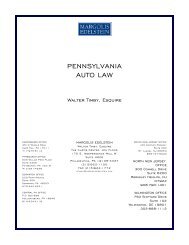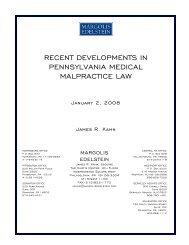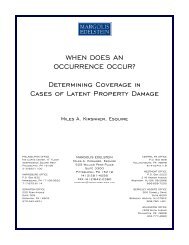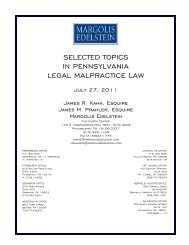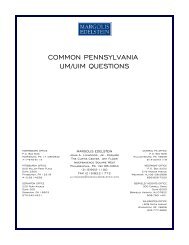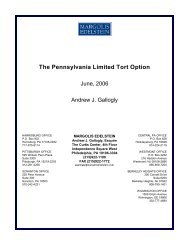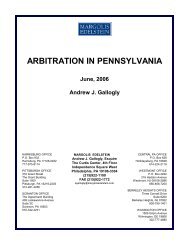Commercial General Liability Coverage Exclusions Under
Commercial General Liability Coverage Exclusions Under
Commercial General Liability Coverage Exclusions Under
You also want an ePaper? Increase the reach of your titles
YUMPU automatically turns print PDFs into web optimized ePapers that Google loves.
custody or control”, it should initially be noted that the exclusion applies only to personal property,<br />
as opposed to real property. It has been held that the policy term “personal property” is<br />
unambiguous and refers to everything that is the subject of ownership other than real estate. Hartford<br />
Ins. Co. v. B. Barks & Sons, Inc., 1999 U.S. Dist. LEXIS 7733 (E.D.Pa. 1999). Chattels that are not<br />
physically attached to real estate are always considered personal property, but those which are<br />
permanently attached to realty in such a manner that they cannot be removed without materially<br />
damaging the property, or which are fixtures essential to the use of the building are considered real<br />
property. See, Noll v. Harrisburg YMCA, 643 A.2d 81 (Pa. 1994); Lehman v. Keller, 684 A.2d 18<br />
(Pa. 1996).<br />
• <strong>Under</strong> current Pennsylvania law, it is unnecessary to the application of the “care, custody or<br />
control” exclusion that the insured have either an ownership interest in, or “exclusive control” of<br />
the property at the time it is damaged - an insured’s physical possession of the property is sufficient.<br />
The mere presence of the property owner’s representatives while an insured is handling the property<br />
at issue does not render the exclusion inapplicable, though the situation might differ depending upon<br />
the degree of control still exercised by the owner’s representatives at the time. It has also been held<br />
that, for the exclusion to apply, an insured contractor’s possession of the property must be “a<br />
necessary element of the work involved”, rather than being “merely incidental” to the work.<br />
International Derrick & Equipment Co. v. Buxbaum, 240 F.2d 536 (3d Cir. 1957), (holding that<br />
exclusion applied where insured hired to install antenna mast on broadcasting tower allowed it to<br />
fall to the ground, despite insured’s lack of proprietary interest in the mast and despite presence of<br />
owner’s representatives at the time) ; Masters v. Celina Mutual Ins. Co., 224 A.2d 774 (Pa.Super.<br />
1966), (adopting International Derrick and holding that exclusion unambiguously applied where<br />
insured destroyed a derrick which it had been hired to move in a stone quarry when a cable on the<br />
insured’s crane snapped); Slate Construction Co. v. Bituminous Casualty Corp., 323 A.2d 141<br />
(Pa.Super. 1974), (holding that exclusion was ambiguous under circumstances where damage to<br />
property was caused by the insured’s subcontractor, but that property is generally within an insured’s<br />
“care, custody or control” whenever it is being moved by an insured under contract, is being put in<br />
place by an insured under contract, or is possessed by an insured as a “bailee”). Compare, Boswell<br />
v. Travelers Indemnity Co., 120 A.2d 250 (N.J.Super. 1956), (exclusion did not apply where<br />
damaged heating units handled by insured were under continuous supervision of the owner’s<br />
maintenance engineer).<br />
• It is unclear in Pennsylvania whether this exclusion will apply to cases in which an insured<br />
has handled property without the owner’s consent. Pfeiffer v. Grocers Mutual Ins. Co., 379 A.2d<br />
118 (Pa.Super. 1977), (noting conflicting authorities on this issue and declining to decide the<br />
question when deciding case on other grounds).<br />
• Regarding Paragraph (5), barring coverage for damage to “that particular part of real<br />
property on which you or your subcontractors or subcontractors ... are performing operations,” will<br />
apply by reason of that present-tense (“are performing”) language only to damage which occurs (or<br />
becomes manifest) while the work is ongoing and actually in progress, having no application to an<br />
insured’s completed operations, or arguably, to any injury occurring at a time when the insured or<br />
16



